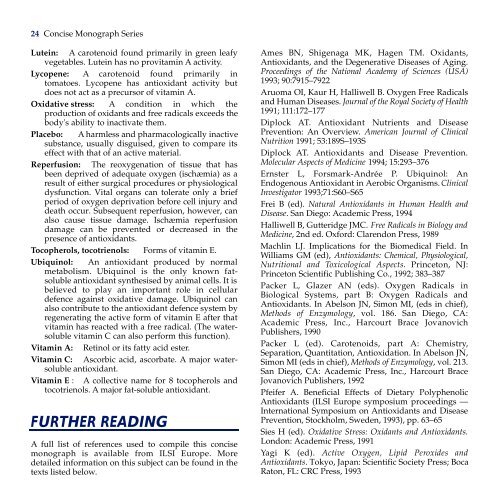Oxidants, Antioxidants and Disease Prevention - Aara-Super food
Oxidants, Antioxidants and Disease Prevention - Aara-Super food
Oxidants, Antioxidants and Disease Prevention - Aara-Super food
Create successful ePaper yourself
Turn your PDF publications into a flip-book with our unique Google optimized e-Paper software.
24 Concise Monograph Series<br />
Lutein: A carotenoid found primarily in green leafy<br />
vegetables. Lutein has no provitamin A activity.<br />
Lycopene: A c a rotenoid found primarily in<br />
tomatoes. Lycopene has antioxidant activity but<br />
does not act as a precursor of vitamin A.<br />
Oxidative stress: A condition in which the<br />
production of oxidants <strong>and</strong> free radicals exceeds the<br />
body's ability to inactivate them.<br />
Placebo: A harmless <strong>and</strong> pharmacologically inactive<br />
substance, usually disguised, given to compare its<br />
effect with that of an active material.<br />
Reperfusion: The reoxygenation of tissue that has<br />
been deprived of adequate oxygen (ischæmia) as a<br />
result of either surgical procedures or physiological<br />
dysfunction. Vital organs can tolerate only a brief<br />
period of oxygen deprivation before cell injury <strong>and</strong><br />
death occur. Subsequent reperfusion, however, can<br />
also cause tissue damage. Ischæmia reperfusion<br />
damage can be prevented or decreased in the<br />
presence of antioxidants.<br />
Tocopherols, tocotrienols: Forms of vitamin E.<br />
Ubiquinol: An antioxidant produced by normal<br />
metabolism. Ubiquinol is the only known fatsoluble<br />
antioxidant synthesised by animal cells. It is<br />
believed to play an important role in cellular<br />
defence against oxidative damage. Ubiquinol can<br />
also contribute to the antioxidant defence system by<br />
regenerating the active form of vitamin E after that<br />
vitamin has reacted with a free radical. (The watersoluble<br />
vitamin C can also perform this function).<br />
Vitamin A: Retinol or its fatty acid ester.<br />
Vitamin C: Ascorbic acid, ascorbate. A major watersoluble<br />
antioxidant.<br />
Vitamin E : A collective name for 8 tocopherols <strong>and</strong><br />
tocotrienols. A major fat-soluble antioxidant.<br />
FURTHER READING<br />
A full list of references used to compile this concise<br />
monograph is available from ILSI Europe. More<br />
detailed information on this subject can be found in the<br />
texts listed below.<br />
Ames BN, Shigenaga MK, Hagen TM. <strong>Oxidants</strong>,<br />
<strong>Antioxidants</strong>, <strong>and</strong> the Degenerative <strong>Disease</strong>s of Aging.<br />
Proceedings of the National Academy of Sciences (USA)<br />
1993; 90:7915–7922<br />
Aruoma OI, Kaur H, Halliwell B. Oxygen Free Radicals<br />
<strong>and</strong> Human <strong>Disease</strong>s. Journal of the Royal Society of Health<br />
1991; 111:172–177<br />
Diplock AT. Antioxidant Nutrients <strong>and</strong> <strong>Disease</strong><br />
<strong>Prevention</strong>: An Overview. American Journal of Clinical<br />
Nutrition 1991; 53:189S–193S<br />
Diplock AT. <strong>Antioxidants</strong> <strong>and</strong> <strong>Disease</strong> Pre v e n t i o n .<br />
Molecular Aspects of Medicine 1994; 15:293–376<br />
Ernster L, Forsmark-Andrée P. Ubiquinol: A n<br />
Endogenous Antioxidant in Aerobic Organisms. Clinical<br />
Investigator 1993;71:S60–S65<br />
Frei B (ed). Natural <strong>Antioxidants</strong> in Human Health <strong>and</strong><br />
<strong>Disease</strong>. San Diego: Academic Press, 1994<br />
Halliwell B, Gutteridge JMC. Free Radicals in Biology <strong>and</strong><br />
Medicine, 2nd ed. Oxford: Clarendon Press, 1989<br />
Machlin LJ. Implications for the Biomedical Field. In<br />
Williams GM (ed), <strong>Antioxidants</strong>: Chemical, Physiological,<br />
Nutritional <strong>and</strong> Toxicological Aspects. Princeton, NJ:<br />
Princeton Scientific Publishing Co., 1992; 383–387<br />
Packer L, Glazer AN (eds). Oxygen Radicals in<br />
Biological Systems, part B: Oxygen Radicals <strong>and</strong><br />
<strong>Antioxidants</strong>. In Abelson JN, Simon MI, (eds in chief),<br />
Methods of Enzymology, vol. 186. San Diego, CA:<br />
Academic Press, Inc., Harcourt Brace Jovanovich<br />
Publishers, 1990<br />
Packer L (ed). Carotenoids, part A: Chemistry,<br />
Separation, Quantitation, Antioxidation. In Abelson JN,<br />
Simon MI (eds in chief), Methods of Enzymology, vol. 213.<br />
San Diego, CA: Academic Press, Inc., Harcourt Brace<br />
Jovanovich Publishers, 1992<br />
Pfeifer A. Beneficial Effects of Dietary Polyphenolic<br />
<strong>Antioxidants</strong> (ILSI Europe symposium proceedings —<br />
International Symposium on <strong>Antioxidants</strong> <strong>and</strong> <strong>Disease</strong><br />
<strong>Prevention</strong>, Stockholm, Sweden, 1993), pp. 63–65<br />
Sies H (ed). Oxidative Stress: <strong>Oxidants</strong> <strong>and</strong> <strong>Antioxidants</strong>.<br />
London: Academic Press, 1991<br />
Yagi K (ed). Active Oxygen, Lipid Peroxides <strong>and</strong><br />
<strong>Antioxidants</strong>. Tokyo, Japan: Scientific Society Press; Boca<br />
Raton, FL: CRC Press, 1993

















